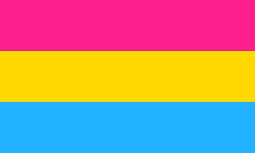Pansexual flag
 | |
| Use | Symbol of pansexuality to distinguish it from bisexuality |
|---|---|
| Proportion | 3:5 |
| Adopted | 2010 |
| Design | Three equally-sized horizontal bars: pink, yellow, cyan |
| Designed by | Jasper V. |
| Part of the LGBTQ series |
| LGBTQ symbols |
|---|
| Symbols |
| Pride flags |
The pansexual flag is a pink, yellow and cyan flag, designed as a symbol for the pansexual community to increase its visibility and recognition, and distinguish itself from bisexuality.[1]
History and use
The flag has been in wide use since the early 2010s when it was posted on an anonymous Tumblr account[2][self-published source][3][self-published source] by its creator Jasper V.[4][5] The flag functions as a symbol of the pansexual community like the rainbow flag is used as a symbol for lesbian, gay, bisexual, transgender people and anyone else in the LGBT community. The pansexual pride flag is used to indicate that pansexuals have sexual attractions and relationships with people of different genders and sexualities.[6][unreliable source] The theory of pansexuality aims to challenge existing prejudices, which can cause judgment, ostracism, and serious disorders within society.[7]
Design and symbolism
The pansexual flag consists of three equally-sized colored horizontal bars, which are—from top to bottom—pink, yellow, and cyan.[8][9][10][11]
Some sources state that the cyan represents attraction to men, pink represents attraction to women, and yellow represents attraction to non-binary people such as those who are agender, bigender and genderfluid.[11][9][12] Other sources state that the colours cyan, pink, and yellow stand for those who identify as men, women and non-binary people, respectively.[8][1][13]
See also
References
- ^ a b Petronzio, Matt (13 June 2014). "A Storied Glossary of Iconic LGBT Flags and Symbols". Mashable. Archived from the original on 20 July 2014. Retrieved 16 November 2022.
- ^ pansexualflag (8 October 2010). "Hex Color Codes..." Archived from the original on 24 August 2011. Retrieved 15 November 2022 – via Tumblr.
- ^ "Do You Have a Flag?". 9 November 2012. Archived from the original on 28 January 2022. Retrieved 17 July 2014.
- ^ Olphin, Olivia (2021). "Is there a new pan flag 2021? New Pride flag confuses Twitter users". The Focus. Retrieved 15 November 2022.
- ^ justjasper (13 February 2013). "confession time". Retrieved 15 November 2022 – via Tumblr.
- ^ "What is Pansexual?". 2017. Archived from the original on 3 June 2018. Retrieved 3 June 2018.
- ^ Boom, Peter (April 2008). "The philosophy of pansexuality". European Federation of Sexology. Retrieved 12 February 2016.
- ^ a b "Want to know more about the rainbow colors? Here's a guide to Pride flag symbolism". KTVU. 4 June 2021. Retrieved 15 November 2022.
- ^ a b Dastagir, Alia E.; Oliver, David (1 June 2021). "LGBTQ Pride flags go beyond the classic rainbow. Here's what each one means". USA Today. Archived from the original on 17 June 2021. Retrieved 15 November 2022.
- ^ David J McLaughlin and Genny Beemyn, Queer Lights: Combining technology, LGBTQIA+ and diversity topics in an accessible and inclusive learning environment, 2018
- ^ a b Damshenas, Sam (27 May 2021). "What do all the different Pride flags stand for?". Gay Times. Retrieved 15 November 2022.
- ^ "A field guide to Pride flags". 27 June 2013. Archived from the original on 24 July 2014. Retrieved 17 July 2014.
- ^ "Mashable publishes an up-to-date compilation of LGBT flags and symbols". GLAAD. 16 June 2014. Retrieved 15 November 2022.
